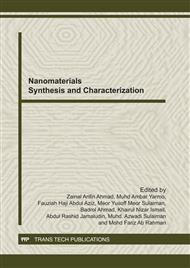[1]
P.T. Mosley, B.C. Tofield. Hilger, Bristol, (1987).
Google Scholar
[2]
H.M. Shang and G.Z. Cao. Imperial College Press Publishing, Sgp. (2007).
Google Scholar
[3]
J. Xu, Y. Zhang, Y. Chen, Q. Xiang, Q. Pan, L. Shi. Mater. Sci. Eng. B Vol. 150 (2008), pp.55-60.
Google Scholar
[4]
. Wan, Q.H. Li, Y.J. Chen, X.L. He, J.P. Li, C.L. Lin. Appl. Phys. Lett., Vol. 84 18, (2004), pp.3654-3656.
Google Scholar
[5]
A. Kolmakov, M. Moskovits. Annu. Rev. Mater. Res. Vol. 34 (2004), pp.151-180.
Google Scholar
[6]
C.F. Dee, T.Y. Tiong, M.M. Salleh, M. Yahaya & B.Y. Majlis. Proceeding of Recent Researches In Communications, Automation, Signal Processing, Nanotechnology, Astronomy and Nuclear Physics, (2010), pp.160-164.
Google Scholar
[7]
L. Liao, Z. Zhang, B. Yan, Z. Zheng, Q.L. Bao, T. Wu, C.M. Li, Z.X. Shen, J.X. Zhang, H. Gong, J.C. Li and T. Yu. Nanotechnology Vol. 20 (2009), 085203.
DOI: 10.1088/0957-4484/20/8/085203
Google Scholar
[8]
M. Law, H. Kind, B. Messer, F. Kim, P. Yang. Angew. Chem. Int. Engl. Vol. 41 (2002), pp.2405-2408.
Google Scholar
[9]
S. Mridha, D. Basak. Semicond. Sci. Technol. Vol. 21 (2006), pp.928-932.
Google Scholar
[10]
Z. Fan, D. Wang, P, Chang, W. Tseng, J.G. Lu. Appl. Phys. Lett. Vol. 85 (2004), pp.5923-5925.
Google Scholar
[11]
Y.W. Heo, D.P. Norton, L.C. Tien, Y. Kwon, B.S. Kang, F. Ren, S.J. Pearton and J.R. LaRoche. Mater. Sci. Eng., R 47 (2004) pp.1-47.
Google Scholar
[12]
S.K. Hazra and S. Basu. Sens. Actuators B Vol. 117 (2006), pp.177-182.
Google Scholar
[13]
H.W. Ryu, B.S. Park, S.A. Akbar, W.S. Lee, K.J. Hong, Y.J. Seo, D.C. Shin, J.S. Park and G.P. Choi. Sens. Actuators B Vol. 96 (2003), p.717.
Google Scholar
[14]
G.S. Trivikrama Rao and D. Tarakarama Rao. Sens. Actuators B Vol. 55 (1999), p.166.
Google Scholar
[15]
C.F. Dee, K.C. Aw, B. Wright, X.D. Yan, C.W. Zou, W. Gao, M.M. Salleh, B.Y. Majlis and J.D. Lee. Materials Science Forum, 663-665, (2010), pp.563-567.
DOI: 10.4028/www.scientific.net/msf.663-665.563
Google Scholar
[16]
T.Y. Tiong, M. Yahaya, C.F. Dee, M.M. Salleh & B.Y. Majlis. Journal of Microengineering and Nanoelectronics Vol. 1 (2010), pp.25-28.
Google Scholar
[17]
B.J. Hansen, N. Kaolin, G. Lu, L. Lin, J. Chen and X. Zhang. J. Phys. Chem. Vol. 114 (2010), pp.2440-2447.
Google Scholar
[18]
A.A. Hasina. Dissertation, University of Maryland, Department of Electrical and Computer Engineering (2008), p.121.
Google Scholar
[19]
M.W. Ahn, K.S. Park, J.H. Heo, J.G. Park, D.W. Kim, K. J. Choi, J.H. Lee and S.H. Hong. Appl. Phys. Lett. Vol. 93 (2008), p.263103.
Google Scholar
[20]
E. Comini, G. Faglia, M. Ferroni and G. Sberveglieri. Appl. Phys. A Vol. 88 (2007), pp.45-48.
Google Scholar
[21]
M.W. Ahn, K.S. Park, J.H. Heo, D.W. Kim, K.J. Choi and J. -G. Park. Sens. Actuators B Vol. 138 (2009), pp.168-173.
Google Scholar
[22]
L. Luo, B.D. Sosnowchik, and L.W. Lin. IEEE MEMS (2008), pp.216-219.
Google Scholar


